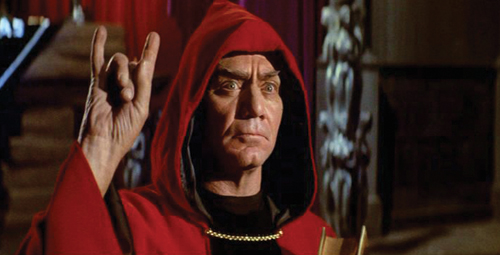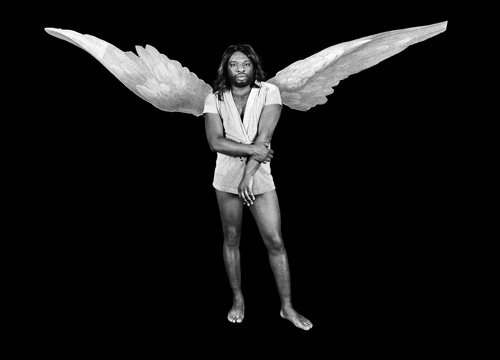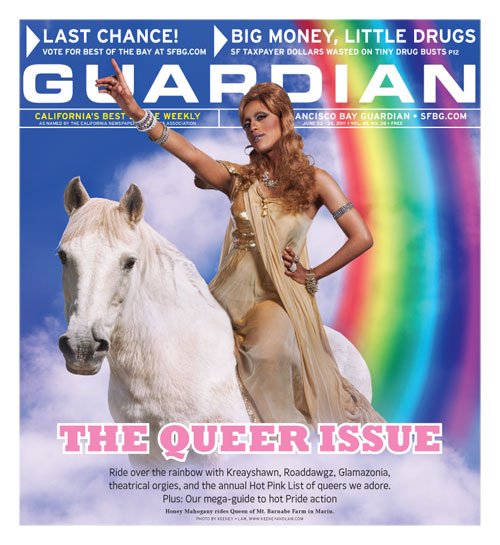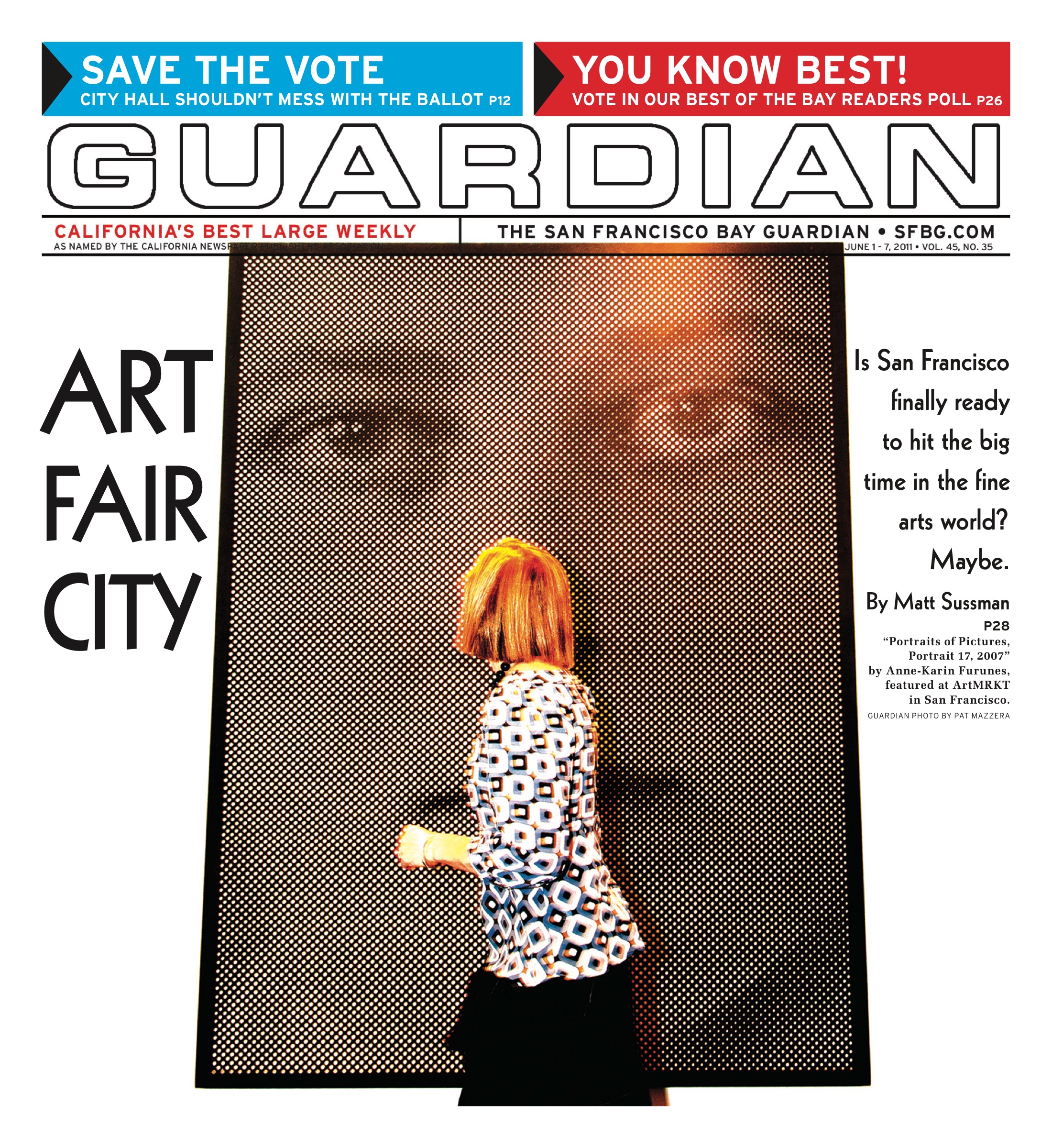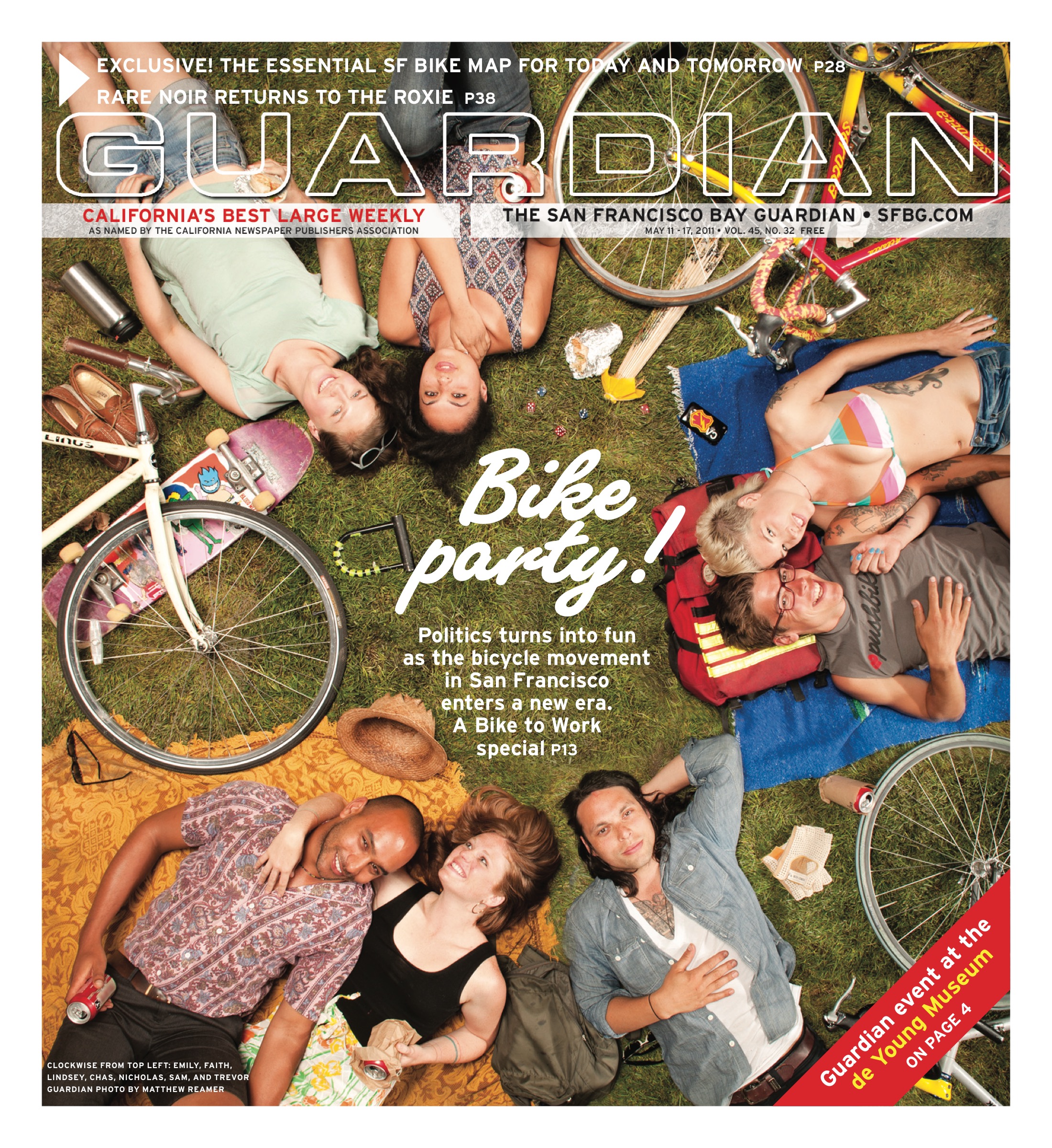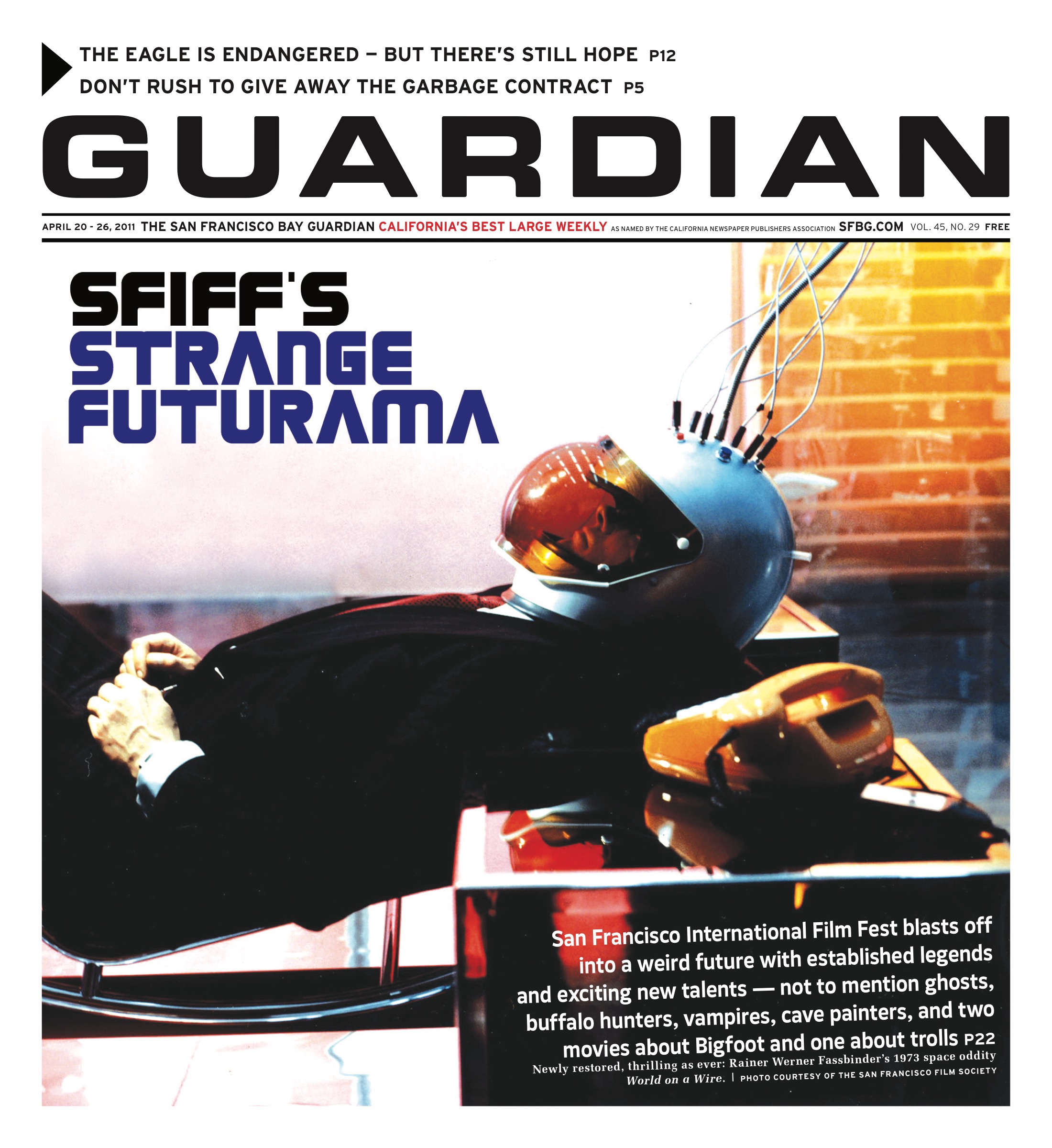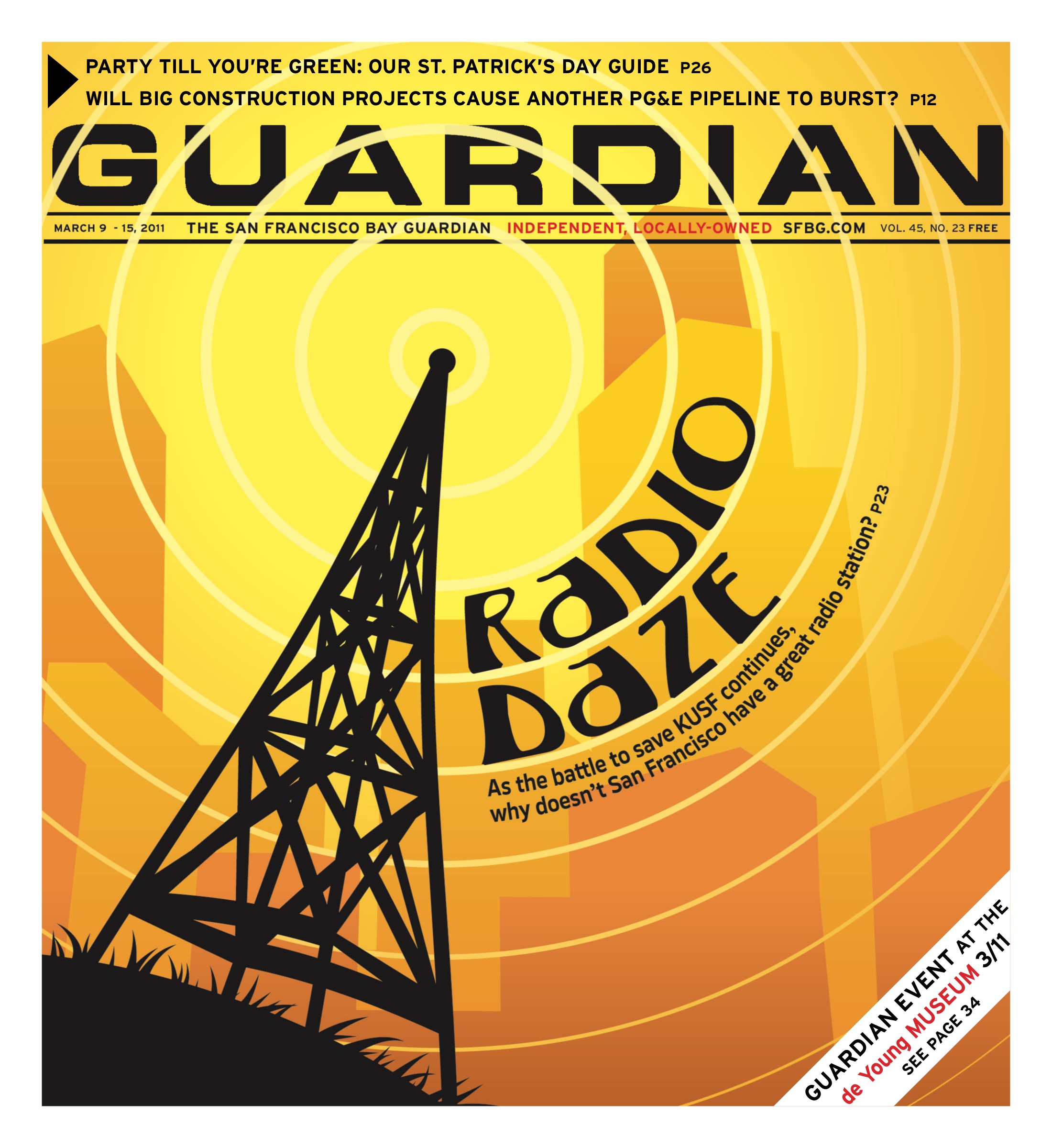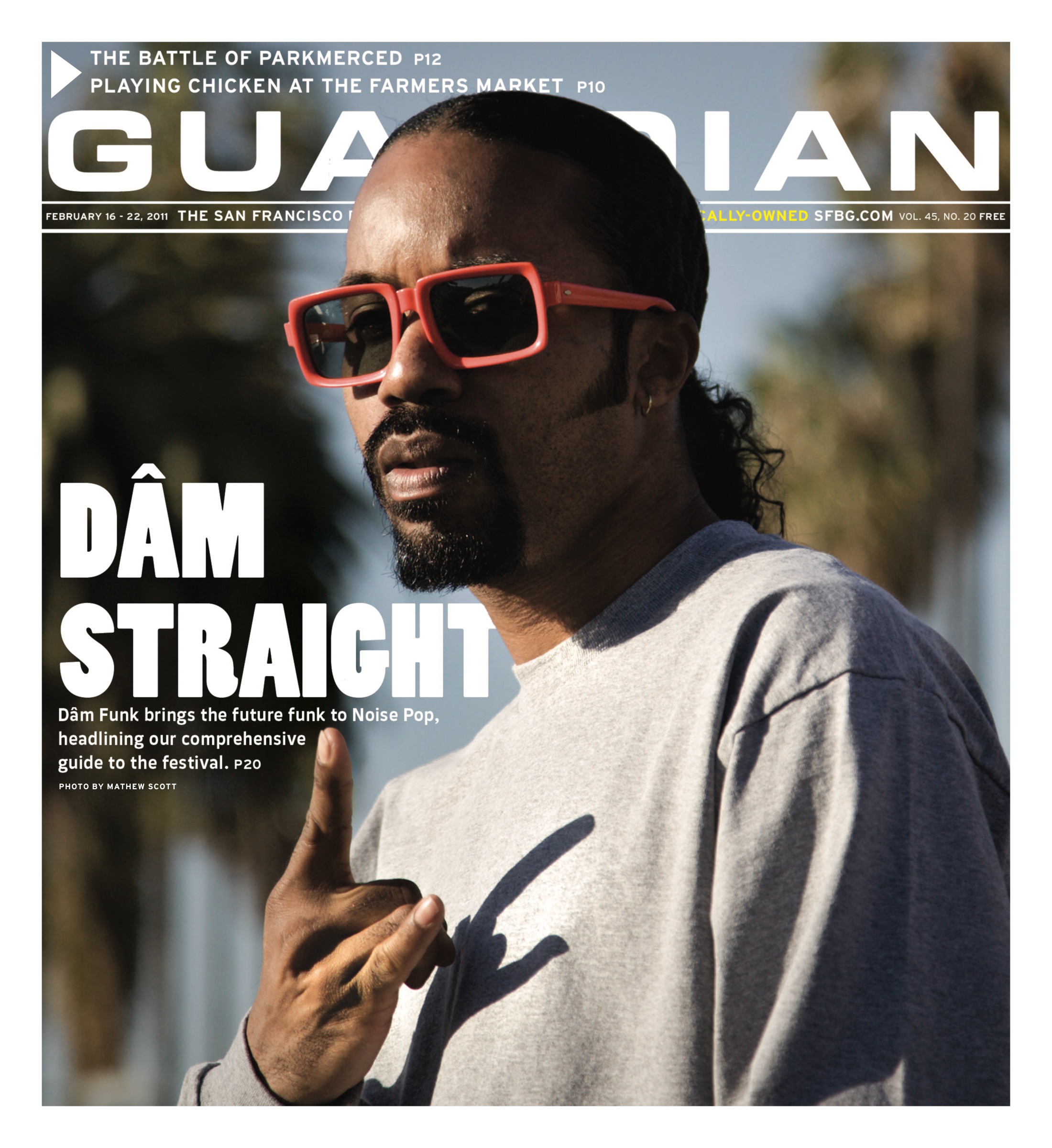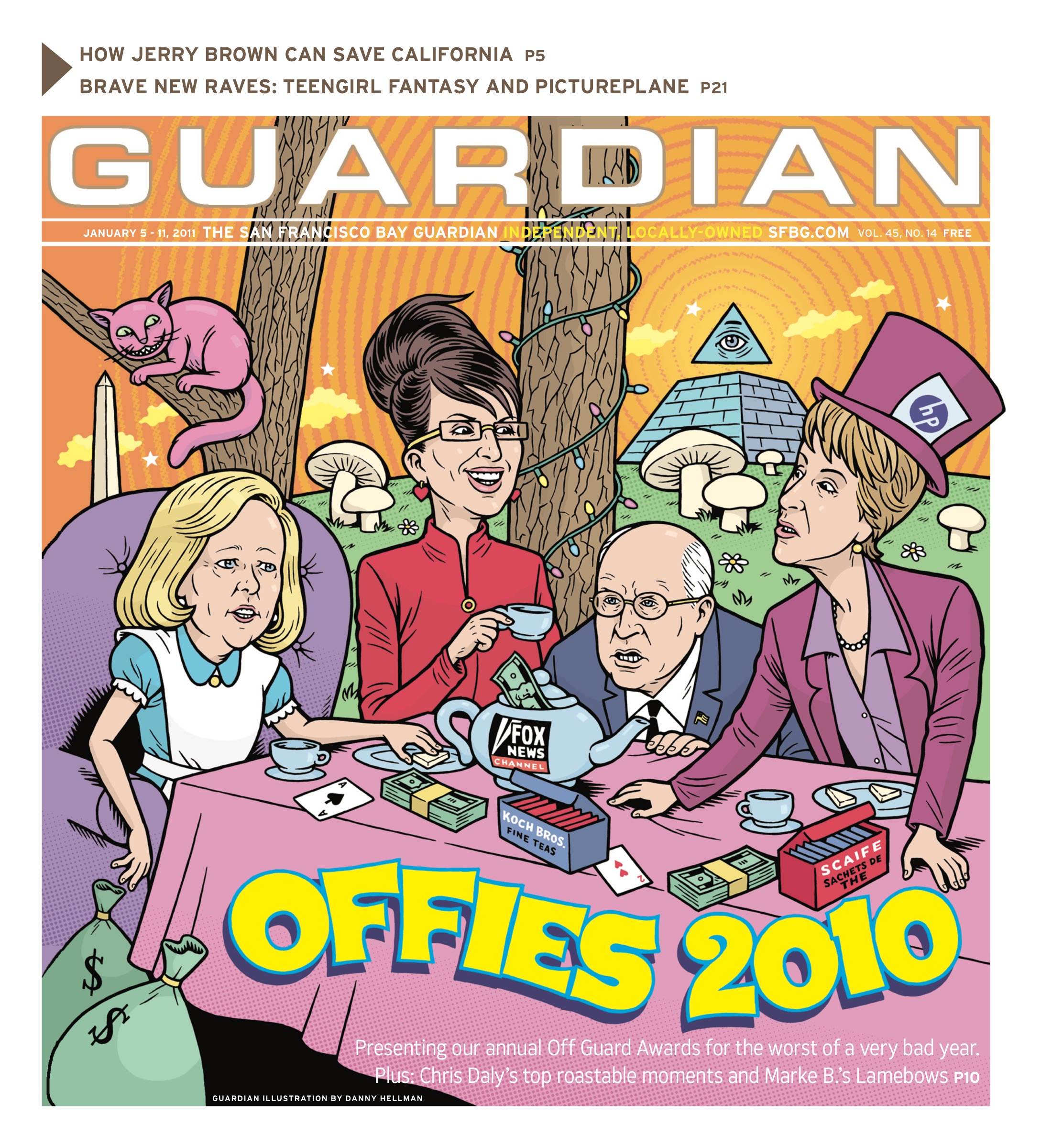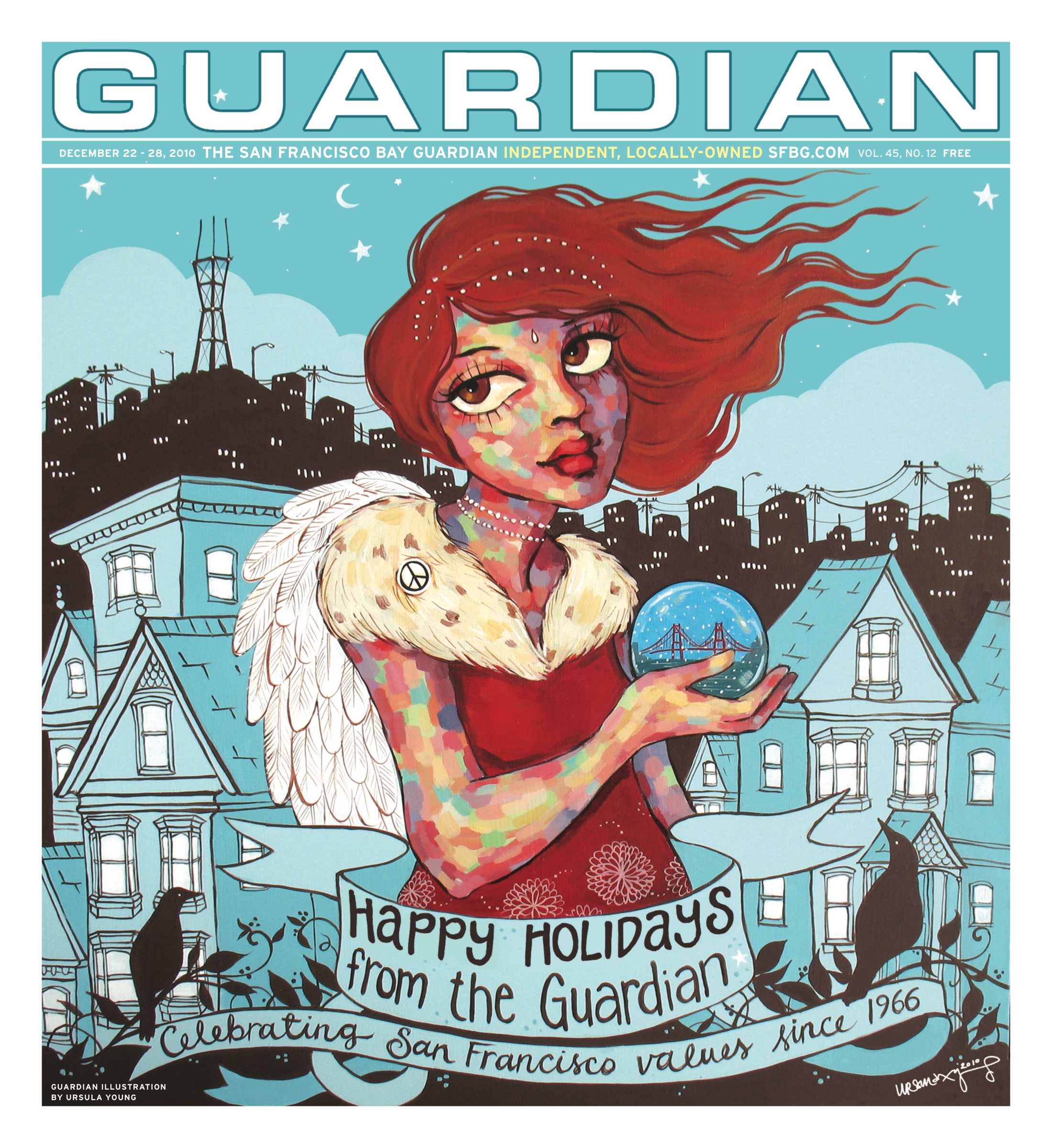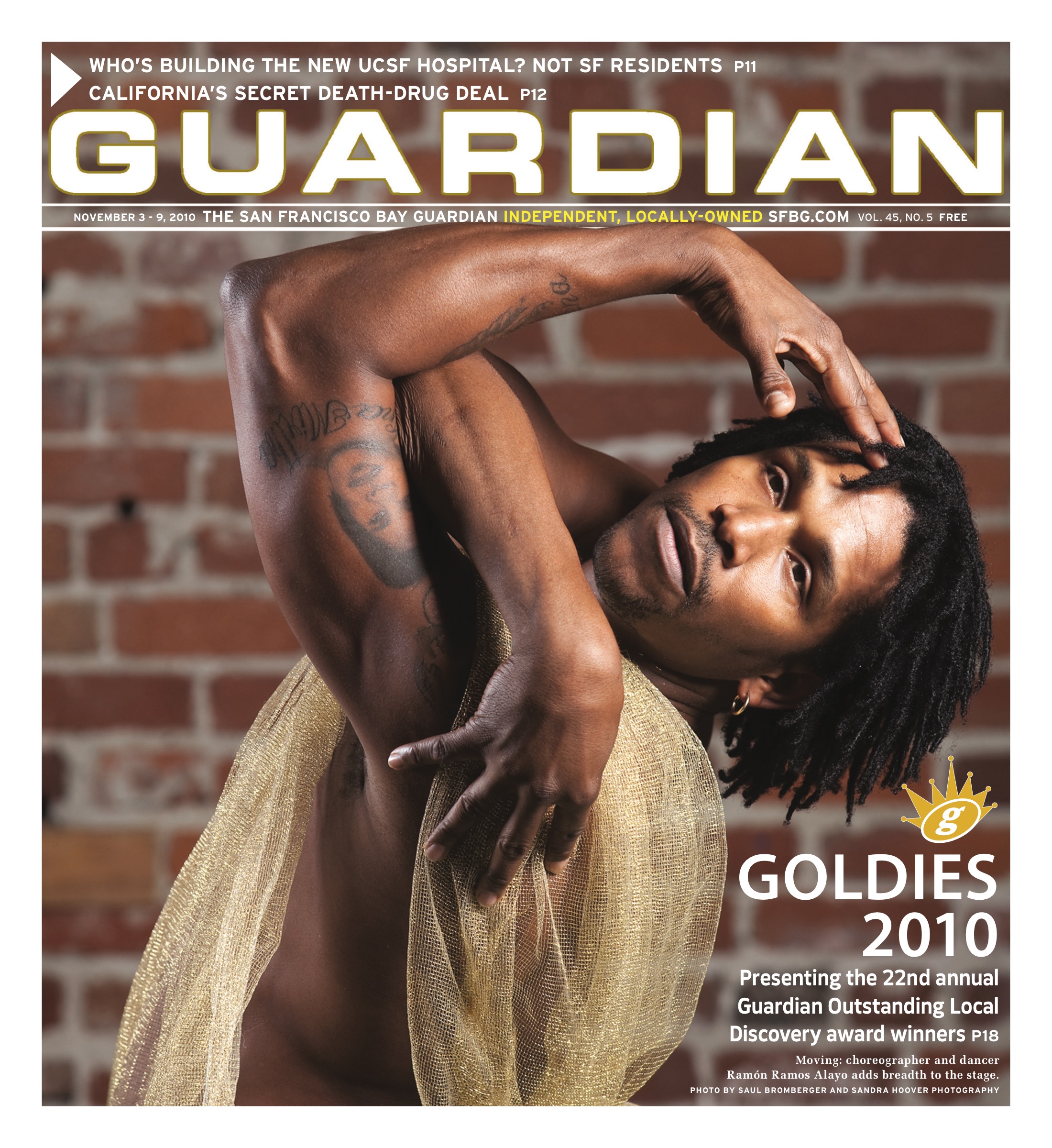Music listings are compiled by Cheryl Eddy. Since club life is unpredictable, it’s a good idea to call ahead to confirm bookings and hours. Prices are listed when provided to us. Submit items for the listings at listings@sfbg.com. For further information on how to submit items for the listings, see Picks.
WEDNESDAY 6
ROCK/BLUES/HIP-HOP
Ani DiFranco Fillmore. 8pm, $33.50.
Fences, Rin Tin Tiger, Passenger and Pilot Rickshaw Stop. 8pm, $10.
Emma Jean Foster and Glide Gospel 50 Mason Social House, 50 Mason, SF; www.50masonsocialhouse.com. 9pm, free.
Aaron Glass and friends, Mowgli’s, Sufis Elbo Room. 9pm, $8.
A Rocket to the Moon, Valencia, Anarbor, Runner Runner Bottom of the Hill. 7pm, $15.
Spider Heart Submission, 2183 Mission, SF; www.sf-submission.com. 10pm, $5.
JAZZ/NEW MUSIC
Cosmo Alleycats Le Colonial, 20 Cosmo, SF; www.lecolonialsf.com. 7pm.
Dink Dink Dink, Gaucho, Michael Abraham Amnesia. 7pm, free.
Ben Marcato and the Mondo Combo Top of the Mark. 7:30pm, $10.
Michael Parsons Revolution Café, 3248 22nd St, SF; (415) 642-0474. 8:30pm, free.
Denise Perrier Rrazz Room. 8pm, $30.
DANCE CLUBS
Booty Call Q-Bar, 456 Castro, SF; www.bootycallwednesdays.com. 9pm. Juanita Moore hosts this dance party, featuring DJ Robot Hustle.
Buena Onda Little Baobab, 3388 19th St., SF; (415) 643-3558. 10pm, $3. Soul, funk, swing, and rare grooves with residents Dr. Musco and DJB.
Cannonball Beauty Bar. 10pm, free. Rock, indie, and nu-disco with DJ White Mike.
Jam Fresh Wednesdays Vessel, 85 Campton, SF; (415) 433-8585. 9:30pm, free. With DJs Slick D, Chris Clouse, Rich Era, Don Lynch, and more spinning top40, mashups, hip hop, and remixes.
Mary-Go-Round Lookout, 3600 16th St, SF; (415) 431-0306. 10pm, $5. A weekly drag show with hosts Cookie Dough, Pollo Del Mar, and Suppositori Spelling.
No Room For Squares Som., 2925 16th St, SF; (415) 558-8521. 6-10pm, free. DJ Afrodite Shake spins jazz for happy hour.
Respect Wednesdays End Up. 10pm, $5. Rotating DJs Daddy Rolo, Young Fyah, Irie Dole, I-Vier, Sake One, Serg, and more spinning reggae, dancehall, roots, lovers rock, and mash ups.
Synchronize Il Pirata, 2007 16th St, SF; (415) 626-2626. 10pm, free. Psychedelic dance music with DJs Helios, Gatto Matto, Psy Lotus, Intergalactoid, and guests.
THURSDAY 7
ROCK/BLUES/HIP-HOP
Dark Star Orchestra Great American Music Hall. 9pm, $35.
Dodos, Reading Rainbow Fillmore. 8pm, $18.50.
Futur Skullz, Blown to Bits, Trouble Kidz, Born Uglies Eagle Tavern. 9:30pm, $7.
Heavy Metal Kings, Danny Diablo Slim’s. 8:30pm, $18.
Hydrophonic, Burn River Burn, Electric Shepherd Bottom of the Hill. 9pm, $8.
Loto Ball, Moira Scar, Tunnel Hemlock Tavern. 9pm, $7.
Peelander-Z, Anamanaguchi, Glowing Stars DNA Lounge. 8pm, $16.
Ron Sexsmith, Caitlin Rose Café Du Nord. 9pm, $16.
“Shock and Roll Therapy” Stud. 8pm, free. With Havarti Party, Poor Sons, Narooma, and Cool Ghouls.
Society 50 Mason Social House, 50 Mason, SF; www.50masonsocialhouse.com. 9pm, free.
Sounds, K.Flay, DJ Aaron Axelsen, Miles the DJ Rickshaw Stop. 9pm, $14.
Tycho, Inu, Soma FM DJs Independent. 8pm, $20. SOMA FM 11th anniversary party.
JAZZ/NEW MUSIC
“Activating the Medium XIV: Radio: Chapter One” San Francisco Museum of Modern Art, 151 Third St, SF; www.sfmoma.org. 7pm, $10. With Richard Garet and Jim Haynes and Allison Holt.
Raul Midion Yoshi’s San Francisco. 8pm, $28.
Organsm featuring Jim Gunderson and “Tender” Tim Shea Bollyhood Café. 6:30-9pm, free.
Stompy Jones Top of the Mark. 7:30pm, $10.
FOLK/WORLD/COUNTRY
Bill Monroe Tribute Band Atlas Café. 8-10pm, free.
Chris Milam Revolution Café, 3248 22nd St, SF; (415) 642-0474. 8:30pm, free.
Rafael and Ingrid Red Poppy Art House. 7pm, $12.
“Twang! Honky Tonk” Fiddler’s Green, 1330 Columbus, SF; www.twanghonkytonk.com. 5pm.
DANCE CLUBS
Afrolicious Elbo Room. 9:30pm, $5. DJs Pleasuremaker and Señor Oz spin Afrobeat, tropicália, electro, samba, and funk.
Caribbean Connection Little Baobab, 3388 19th St, SF; (415) 643-3558. 10pm, $3. DJ Stevie B and guests spin reggae, soca, zouk, reggaetón, and more.
Club Jammies Edinburgh Castle. 10pm, free. DJs EBERrad and White Mice spinning reggae, punk, dub, and post punk.
Culture Corner Koko Cocktails, 1060 Geary, SF; www.kokococktails.com. 10pm, free. Roots reggae, dub, rocksteady, and classic dancehall with DJ Tomas’ Bunny Wailer and Big Youth Birthday Celebration.
Diapers, Binkies, and Friends Knockout. 9:30pm, free. Dad-to-be Jamie Jams spins baby-themed jams with DJs Stab Master Arson and DJ Eli Glad.
Drop the Pressure Underground SF. 6-10pm, free. Electro, house, and datafunk highlight this weekly happy hour.
Electric Feel Lookout, 2600 16th St, SF; www.fringesf.com. 9pm, $2. Indie music video dance party with subOctave and Blondie K, plus guest DJ Candy.
80s Night Cat Club. 9pm, $6 (free before 9:30pm). Two dance floors bumpin’ with the best of 80s mainstream and underground with Dangerous Dan, Skip, Low Life, and guests.
Wolfgang Gartner Ruby Skye. 9pm, $25.
Guilty Pleasures Gestalt, 3159 16th St, SF; (415) 560-0137. 9:30pm, free. DJ TophZilla, Rob Metal, DJ Stef, and Disco-D spin punk, metal, electro-funk, and 80s.
Holy Thursday Underground SF. 10pm, $5. Bay Area electronic hip hop producers showcase their cutting edge styles monthly.
Jivin’ Dirty Disco Butter, 354 11th St., SF; (415) 863-5964. 8pm, free. With DJs spinning disco, funk, and classics.
Lacquer Beauty Bar. 10pm-2am, free. DJs Mario Muse and Miss Margo bring the electro.
Mestiza Bollywood Café, 3376 19th St, SF; (415) 970-0362. 10pm, free. Showcasing progressive Latin and global beats with DJ Juan Data.
1984 Mighty. 9pm, $2. The long-running New Wave and 80s party has a new venue, featuring video DJs Mark Andrus, Don Lynch, and celebrity guests.
Peaches Skylark, 10pm, free. With an all female DJ line up featuring Deeandroid, Lady Fingaz, That Girl, and Umami spinning hip hop.
Thursday Special Tralala Revolution Café, 3248 22nd St, SF; (415) 642-0474. 5pm, free. Downtempo, hip-hop, and freestyle beats by Dr. Musco and Unbroken Circle MCs.
FRIDAY 8
ROCK/BLUES/HIP-HOP
Bryan Adams Warfield. 9pm, $25-85.
Akron/Family, Delicate Steve, Honeymoon, DJ Britt Govea Independent. 9pm, $15.
Buxter Hoot’n, Devotionals, Nick Jaina Café Du Nord. 9:30pm, $10.
Danielson, Battlehooch, Half-handed Cloud Bottom of the Hill. 10pm, $13.
Dark Star Orchestra Great American Music Hall. 9pm, $35.
Fiver Brown and the Good Sinners 50 Mason Social House, 50 Mason, SF; www.50masonsocialhouse.com. 9pm, free.
Larry Graham and Graham Central Station Yoshi’s San Francisco. 8 and 10pm, $30-38.
Hillside Fire, Narwhal Brigade, Ayurveda, Sandy Greenfield Band Kimo’s. 9pm.
Hot Lunch, Blank Stares, Pre-Legendary and the Dreamers Hemlock Tavern. 9:30pm, $7.
Mantles, Wrong Words, Lenz, Wet Illustrated Knockout. 9pm, $7.
Or the Whale, Chamberlin, Steve Taylor Rickshaw Stop. 8:30pm, $12.
Protest the Hero, Maylene and the Sons of Disaster, TesseracT Slim’s. 8:30pm, $17.
Volbeat, Damned Things Fillmore. 7pm, $22.50.
JAZZ/NEW MUSIC
Black Market Jazz Orchestra Top of the Mark. 9pm, $10.
Empty Space Revolution Café, 3248 22nd St, SF; (415) 642-0474. 9pm, free.
Madeleine Peyroux Palace of Fine Arts, 3301 Lyon, SF; www.sfjazz.org. 8pm, $30-75.
Redshift, Rootstock Community Music Center, 544 Capp, SF; www.sfcmc.org. 8pm, $10.
FOLK/WORLD/COUNTRY
“Cowpokes, Gunslingers, and Outlaw Country” Red Devil Lounge. 9pm, $12. With Good Luck Thrift Store Outfit, Whisky Richards, Tiny Television, and Preservation.
Tito y Su Son De Cuba Quinteto Red Poppy Art House. 8pm, $12-15.
DANCE CLUBS
Afro Bao Little Baobab, 3388 19th St, SF; (415) 643-3558. 10pm, $5. Afro and world music with rotating DJs including Stepwise, Steve, Claude, Santero, and Elembe.
Bass Time Continuum Session 4 Club Six. 9pm, $5. With Lotus Drops, Energy Alchemist, Bitch Plz, Benito, and Mr. Rise.
Blow Up DNA Lounge. 10pm, $10-15. “Miss Blow Up USA Pageant” with Jeffrey Paradise.
Cartagena! CD release party Elbo Room. 10pm, $5. Cumbia with DJs Beto, Vinnie Esparza, and B. Cause.
Deeper 222 Hyde, 222 Hyde, SF; (415) 345-8222. 9pm, $10. With rotating DJs spinning dubstep and techno.
Dirty Rotten Dance Party Madrone Art Bar. 9pm, $5. With DJs Morale, Kap10 Harris, and Shane King spinning electro, bootybass, crunk, swampy breaks, hyphy, rap, and party classics.
Exhale, Fridays Project One Gallery, 251 Rhode Island, SF; (415) 465-2129. 5pm, $5. Happy hour with art, fine food, and music with Vin Sol, King Most, DJ Centipede, and Shane King.
Fo’ Sho! Fridays Madrone Art Bar. 10pm, $5. DJs Kung Fu Chris and Makossa spin rare grooves, soul, funk, and hip-hop classics.
Fubar Fridays Butter, 354 11th St., SF; (415) 863-5964. 6pm, $5. With DJs spinning retro mashup remixes.
Good Life Fridays Apartment 24, 440 Broadway, SF; (415) 989-3434. 10pm, $10. With DJ Brian spinning hip hop, mashups, and top 40.
Hot Chocolate Milk. 9pm, $5. With DJs Big Fat Frog, Chardmo, DuseRock, and more spinning old and new school funk.
Rockabilly Fridays Jay N Bee Club, 2736 20th St, SF; (415) 824-4190. 9pm, free. With DJs Rockin’ Raul, Oakie Oran, Sergio Iglesias, and Tanoa “Samoa Boy” spinning 50s and 60s Doo Wop, Rockabilly, Bop, Jive, and more.
Some Thing Stud. 10pm, $7. VivvyAnne Forevermore, Glamamore, and DJ Down-E give you fierce drag shows and afterhours dancing.
Vintage Orson, 508 Fourth St, SF; (415) 777-1508. 5:30-11pm, free. DJ TophOne and guest spin jazzy beats for cocktalians.
SATURDAY 9
ROCK/BLUES/HIP-HOP
Jeff Beck, Imelda May Fillmore. 8pm, $75.
Danger Babes 50 Mason Social House, 50 Mason, SF; www.50masonsocialhouse.com. 9pm, free.
Dark Star Orchestra Great American Music Hall. 9pm, $35.
Deskonocidos, Criaturas, Needles, Ruleta Rusa Knockout. 10pm, $7.
Funk Bros Revolution Café, 3248 22nd St, SF; (415) 642-0474. 9pm, free.
Larry Graham and Graham Central Station Yoshi’s San Francisco. 8 and 10pm, $38.
Jesse Morris and the Man Cougars Riptide Bar. 9pm, free.
Papercuts, Banjo or Freakout Café Du Nord. 9:30pm, $14.
Pollux, Bonnie Dune, Lite Brite Bottom of the Hill. 10pm, $12.
Rise Against, Bad Religion, Four Year Strong Bill Graham Civic Auditorium, 99 Grove, SF; www.ticketmaster.com. 7:30pm, $32.50.
Shearing Pinx, Continues, Victory and Associates Hemlock Tavern. 9:30pm, $7.
Submarines, Nik Freitas Slim’s. 9pm, $16.
FOLK/WORLD/COUNTRY
Hypnotist Collectors, Shareef Ali and the Radical Folksonomy, Fancy Dan Band, Slow Motion Cowboys Hotel Utah. 8pm, $8.
Mamacoatl Red Poppy Art House. 8pm, $15.
Craig Ventresco and Meredith Axelrod Atlas Café. 4pm, free.
DANCE CLUBS
Afro Bao Little Baobab, 3388 19th St, SF; (415) 643-3558. 10pm, $5. Afro and world music with rotating DJs including Stepwise, Steve, Claude, Santero, and Elembe.
Bootie SF: Halloween in April DNA Lounge. 9pm, $6-12. Who says Halloween only comes once a year? Mash it up with DJs Adrian and Mysterious D, guest Faroff, and more.
Club Gossip Cat Club. 9pm, $5-8. Pay tribute to Janet Jackson and other 80s ladies at this party guest-hosted by the Bay Area Flash Mob.
New Wave City New Order Tribute Mezzanine. 9pm, $7-12. Celebrate “Blue Monday” on a Saturday with DJ Shindog, guest Andy T, and more.
Rock City Butter, 354 11th St., SF; (415) 863-5964. 6pm, $5 after 10pm. With DJs spinning party rock.
Same Sex Salsa and Swing Magnet, 4122 18th St, SF; (415) 305-8242. 7pm, free.
Spirit Fingers Sessions 330 Ritch. 9pm, free. With DJ Morse Code and live guest performances.
Spotlight Siberia, 314 11th St, SF; (415) 552-2100. 10pm. With DJs Slowpoke, Double Impact, and Moe1.
Tormenta Tropical Elbo Room. 10pm. Electro cumbia with Chancha Via Circuito, El G, and DJs Shawn Reynaldo and Oro 11.
SUNDAY 10
ROCK/BLUES/HIP-HOP
Band of Heathens Slim’s. 7:30pm, $15.
Let the Night Roar, Pigs Hemlock Tavern. 9pm, $6.
G. Love and Special Sauce, Belle Brigade Fillmore. 8pm, $25.
Mark Growden and His Tucson String Band, Conspiracy of Venus Amnesia. 9pm, $10.
John Mellencamp Warfield. 7pm, $49.50-130.
Sleepytime Gorilla Museum, Now You, Listo Independent. 8pm, $18.
Whiskerman, 7 Orange ABC, Magic Leaves Bottom of the Hill. 9pm, $8.
David Wilcox Yoshi’s San Francisco. 7pm, $25.
JAZZ/NEW MUSIC
Assad Brothers Palace of Fine Arts, 3301 Lyon, SF; www.sfjazz.org. 7pm, $25-60.
John Santos Bliss Bar, 4026 24th St., SF; www.blissbarsf.com. 4:30pm, $10.
Tom Lander Duo Medjool, 2522 Mission, SF; www.medjoolsf.com. 6-9pm, free.
FOLK/WORLD/COUNTRY
Family Folk Explosion Revolution Café, 3248 22nd St, SF; (415) 642-0474. 8:30pm, free.
Jenny Lynn and Her Gone Daddies Thee Parkside. 4pm, free.
“San Francisco Festival of the Mandolins” Croatian American Cultural Center, 60 Onondaga, SF; www.croatianamericanweb.org. 10am-5pm, $15.
DANCE CLUBS
Batcave Cat Club. 10pm, $5. Death rock, goth, and post-punk with Steeplerot Necromos and c_death. Dub Mission Elbo Room. 9pm, $6. Dub, roots, and classic dancehall with DJ Sep, Vinnie Esparza, and guest Adam Twelve.
Gloss Sundays Trigger, 2344 Market, SF; (415) 551-CLUB. 7pm. With DJ Hawthorne spinning house, funk, soul, retro, and disco.
Honey Soundsystem Paradise Lounge. 8pm-2am. “Dance floor for dancers – sound system for lovers.” Got that?
La Pachanga Blue Macaw, 2565 Mission, SF; www.thebluemacawsf.com. 6pm, $10. Salsa dance party with live Afro-Cuban salsa bands.
MONDAY 11
ROCK/BLUES/HIP-HOP
Elephant and Castle, Pixel Memory, Butterfly Bones Elbo Room. 9pm, $5.
Moon Duo, Royal Baths, Lilac Bottom of the Hill. 9pm, $10.
Scala and Kolacny Brothers Independent. 8pm, $25.
JAZZ/NEW MUSIC
Broun Fellinis Yoshi’s San Francisco. 8pm, $25.
Lavay Smith Orbit Room, 1900 Market, SF; (415) 252-9525. 7-10pm, free.
DANCE CLUBS
Death Guild DNA Lounge. 9:30pm, $3-5. Gothic, industrial, and synthpop with Joe Radio, Decay, and Melting Girl.
Krazy Mondays Beauty Bar. 10pm, free. With DJs Ant-1, $ir-Tipp, Ruby Red I, Lo, and Gelo spinning hip hop.
M.O.M. Madrone Art Bar. 6pm, free. With DJ Gordo Cabeza and guests playing all Motown every Monday.
Network Mondays Azul Lounge, One Tillman Pl, SF; www.inhousetalent.com. 9pm, $5. Hip-hop, R&B, and spoken word open mic, plus featured performers.
Sausage Party Rosamunde Sausage Grill, 2832 Mission, SF; (415) 970-9015. 6:30-9:30pm, free. DJ Dandy Dixon spins vintage rock, R&B, global beats, funk, and disco at this happy hour sausage-shack gig.
Skylarking Skylark. 10pm, free. With resident DJs I & I Vibration, Beatnok, and Mr. Lucky and weekly guest DJs.
TUESDAY 12
ROCK/BLUES/HIP-HOP
Olof Arnalds Café Du Nord. 9:30pm, $15.
Amee Chapman, Jenny Kerr, Sugarplums Club Waziema, 543 Divisadero, SF; (415) 356-6641. 8pm, free.
Ms. Lauryn Hill Warfield. 8pm, $59.50-90.
Omar Rodriguez Lopez Group, Zachs Marquise Great American Music Hall. 8pm, $21.
Haroula Rose, TD Lind Hotel Utah. 8pm, $8.
Rural Alberta Advantage, Lord Huron, Vandella Bottom of the Hill. 9pm, $14.
Scala and Kolacny Brothers Independent. 8pm, $25.
Sydney Ducks, Something Fierce Hemlock Tavern. 9pm, $6.
DANCE CLUBS
Boomtown Little Baobab, 3388 19th St, SF; www.bissapbaobab.com. 9pm, free. DJ Mundi spins roots, ragga, dancehall, and more.
Eclectic Company Skylark, 9pm, free. DJs Tones and Jaybee spin old school hip hop, bass, dub, glitch, and electro.
Share the Love Trigger, 2344 Market, SF; (415) 551-CLUB. 5pm, free. With DJ Pam Hubbuck spinning house.

